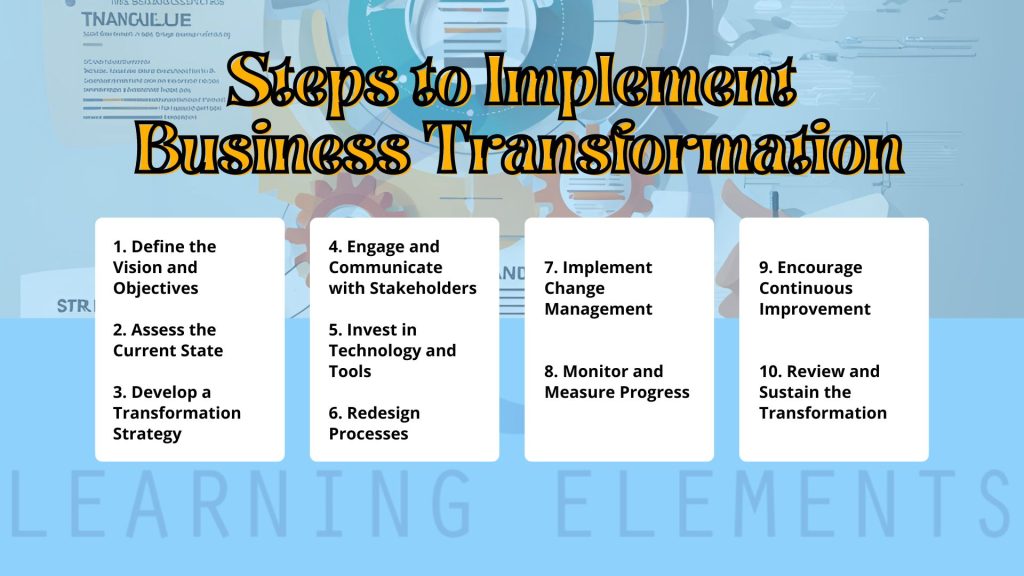Understanding Business Transformation: An In-depth Look at What Business Transformation Entails and How It Can Impact Overall Sales Performance
Business transformation is a comprehensive, strategic approach to changing the way a business operates. It involves rethinking and redesigning business processes, technologies, and organisational structures to improve performance and ensure long-term success. Understanding the importance of business transformation is crucial for any company looking to thrive in today’s competitive market.
Learning Styles in Business Transformation
Business transformation isn’t the only approach to organisational change. It often exists within a broader spectrum of change models, similar to how learning styles in education are categorised. For example, Kolb’s Learning Styles and VARK are to educate what Six Sigma or Lean Management might be to business transformation. Understanding where business transformation fits within this wider context helps companies choose the right tools and strategies for their specific needs.
Key Components of Business Transformation
Business transformation is a comprehensive and structured approach that involves fundamental changes to an organisation’s processes, strategies, and operations to improve performance and achieve long-term goals. Below are the key components of business transformation, particularly in relation to its impact on overall sales performance:
1. Strategic Alignment
Ensuring that the transformation initiatives align with the company’s overall strategic goals. Clear alignment helps in setting the right objectives for the sales teams, leading to better focus and enhanced performance.
2. Process Optimisation
Reengineering and optimising existing business processes to increase efficiency and effectiveness. Streamlined processes can reduce bottlenecks, improve customer service, and lead to quicker sales cycles.
3. Technology Integration
Adopting and integrating new technologies to support business operations and innovation. Implementation of CRM systems, data analytics, and AI can provide valuable insights, automate tasks, and personalise customer interactions, boosting sales.
4. Cultural Change
Shifting the organisational culture to embrace change, innovation, and continuous improvement. A culture that supports transformation encourages sales teams to adapt to new tools, techniques, and approaches, enhancing their ability to meet targets.
5. Customer Focus
Prioritising the needs and expectations of customers throughout the transformation process. A customer-centric approach ensures that products and services are aligned with market demands, leading to increased customer satisfaction and higher sales.
6. Leadership and Governance
Strong leadership and governance structures are essential to guide the transformation and ensure accountability. Effective leadership drives the transformation agenda, motivates sales teams, and ensures that the changes lead to tangible improvements in sales performance.
7. Change Management
Managing the human aspect of change by preparing, supporting, and helping individuals adapt to transformation. Proper change management minimises resistance and helps sales teams transition smoothly to new ways of working, which can positively impact sales outcomes.
8. Data-Driven Decision Making
Utilising data and analytics to make informed decisions throughout the transformation process. Data-driven strategies allow sales teams to target the right customers, forecast trends, and adjust tactics, leading to improved sales performance.
9. Performance Measurement
Establishing metrics and KPIs to measure the success of the transformation initiatives. Regular performance assessments help in identifying areas for improvement, ensuring that the transformation leads to sustained sales growth.
10. Continuous Improvement
Establishing a mindset and processes for ongoing evaluation and enhancement post-transformation. Continuous improvement ensures that the sales processes and strategies remain competitive and adaptable to changing market conditions, securing long-term sales success.
Why is Business Transformation Essential?
Adapting to Market Changes
Companies must adapt to market changes to remain relevant. Business transformation allows businesses to be flexible and responsive to new trends and demands.
Enhancing Competitive Advantage
Staying ahead of the competition requires continuous improvement. Business transformation helps businesses innovate, improve their offerings, and maintain a competitive edge.
Application in Modern Business Environments
In today’s digital age, business transformation is more relevant than ever. Online platforms, remote work, and digital marketing are reshaping traditional business models. Implementing transformation strategies that include technological advancements like AI and machine learning is vital for staying competitive. Modern tools not only streamline processes but also provide deep insights into customer behaviour, enabling more targeted and efficient sales strategies.
Impact on Overall Sales Performance
Improving Customer Engagement
Transformation efforts often lead to better customer engagement. By leveraging new technologies and optimising processes, businesses can provide personalised and efficient customer experiences.
Streamlining Sales Processes
Streamlined sales processes result in more efficient operations. This can lead to increased sales, improved customer satisfaction, and higher revenue.

Steps to Implement Business Transformation
Implementing business transformation requires a systematic approach to ensure that the changes are effective and aligned with the organisation’s goals. Here are the key steps to implement business transformation, with a focus on how it can impact overall sales performance:
1. Define the Vision and Objectives
Action: Clearly articulate the vision for the transformation and set specific objectives. Setting clear, achievable objectives is essential for guiding the transformation process.
Impact on Sales: Establishing a clear vision helps align the sales team’s efforts with the broader transformation goals, ensuring that their activities contribute directly to improved sales performance.
2. Assess the Current State
Action: Conduct a thorough assessment of the existing business processes, technologies, and organisational culture. This involves identifying strengths, weaknesses, opportunities, and threats (SWOT Analysis).
Impact on Sales: Understanding the current state allows for the identification of inefficiencies in the sales process, enabling targeted improvements that can boost sales efficiency and effectiveness.
3. Develop a Transformation Strategy
Action: Create a detailed strategy outlining the steps needed to achieve the transformation goals, including timelines, resources, and key stakeholders.
Not every part of the business may need transformation. Identifying key areas for improvement ensures that efforts are focused where they are most needed. A detailed plan outlines the steps needed to achieve transformational goals. This roadmap ensures that everyone involved understands their roles and responsibilities.
Impact on Sales: A well-developed strategy ensures that sales-related changes are prioritised and that the sales team is adequately supported throughout the transformation process.
4. Engage and Communicate with Stakeholders
Action: Engage with all stakeholders, including employees, customers, and partners, to communicate the transformation plan and its expected benefits.
Impact on Sales: Effective communication ensures that the sales team understands the purpose of the transformation, reducing resistance and fostering a proactive approach to adopting new practices.
5. Invest in Technology and Tools
Action: Identify and implement the necessary technologies and tools to support the transformation.
Impact on Sales: Investing in advanced sales tools, such as CRM systems and data analytics, empowers the sales team to make data-driven decisions, personalise customer interactions, and improve overall sales outcomes.
6. Redesign Processes
Action: Reengineer and optimise business processes to align with the transformation goals.
Impact on Sales: Streamlining sales processes, such as lead management and order fulfilment, reduces inefficiencies, shortens sales cycles, and enhances customer satisfaction, leading to increased sales.
7. Implement Change Management
Action: Develop a change management plan to help employees adapt to new ways of working, including training and support.
Impact on Sales: Providing the sales team with the necessary training and support ensures they are well-equipped to embrace new tools and processes, leading to a smoother transition and better sales performance.
8. Monitor and Measure Progress
Action: Establish metrics and KPIs to track the progress of the transformation and make adjustments as needed.
Impact on Sales: Regular monitoring of sales performance metrics allows for timely interventions, ensuring that the transformation leads to continuous sales improvement.
9. Encourage Continuous Improvement
Action: Foster a culture of continuous improvement by encouraging feedback and ongoing evaluation of the transformation efforts.
Impact on Sales: Continuous improvement initiatives help the sales team stay competitive and responsive to market changes, leading to sustained sales growth over time.
10. Review and Sustain the Transformation
Action: Periodically review the outcomes of the transformation and make adjustments to sustain the improvements.
Impact on Sales: Regular reviews ensure that the sales team continues to benefit from the transformation, maintaining high levels of performance and adapting to evolving business needs.
If you’re ready to take the next step in your business transformation journey or need expert guidance on improving your sales performance, we’re here to help. Contact us today to discuss how we can support your transformation efforts and drive your business towards success.
Considerations for Business Leaders and Teams
Leaders and teams need to align their understanding of transformation with actionable insights. It’s not just about adopting new technologies but also about how those tools are integrated into daily operations. By understanding their specific roles within the transformation, teams can better contribute to the organisation’s overall success. This alignment is crucial for ensuring that the changes lead to measurable improvements in sales performance.

The Role of Technology in Business Transformation
Digital Transformation
Digital transformation will continue to be a major trend. Businesses must embrace digital technologies to stay relevant and competitive.
Leveraging AI and Machine Learning
AI and machine learning can significantly enhance business operations. These technologies enable predictive analytics, automate routine tasks, and improve decision-making.
Importance of Data Analytics
Data analytics provide valuable insights into business performance. Using data to inform strategies helps businesses make better, more informed decisions.
Organisational Change Management
Involving Stakeholders
Successful business transformation requires the involvement of all stakeholders. This includes employees, management, and external partners. Their input and support are crucial for success.
Training and Development
Training and developing employees ensures they have the skills needed to implement and sustain transformation efforts. Continuous learning is vital for keeping up with new technologies and practices.
Optimising Business Processes
Workflow Automation
Automating workflows can greatly enhance efficiency. By reducing manual tasks, businesses can focus on more strategic activities that drive growth.
Reducing Operational Costs
Optimised processes lead to cost savings. By eliminating waste and improving efficiency, businesses can reduce operational expenses.
Example Case of Successful Business Transformations
A service provider improved customer satisfaction and sales by adopting a new CRM system and enhancing their digital marketing strategies.
Measuring Success in Business Transformation
Key Performance Indicators (KPIs)
KPIs are essential for measuring the success of transformation efforts. They provide insights into performance and highlight areas needing improvement.
Continuous Improvement
Transformation is an ongoing process. Continuous improvement ensures that businesses remain competitive and can adapt to future changes.
FAQs
1. What is business transformation?
Business transformation involves rethinking and redesigning business processes, technologies, and organisational structures to improve performance and ensure long-term success.
2. How does business transformation impact sales performance?
Business transformation can improve sales performance by enhancing customer engagement, streamlining sales processes, and leveraging new technologies.
3. What challenges do businesses face during transformation?
Common challenges include resistance to change and managing resource allocation effectively.
Conclusion
Business transformation is essential for staying competitive in today’s market. By understanding and implementing the key components of transformation, businesses can improve their performance and achieve long-term success. It’s not just about adapting to changes but about proactively driving growth and innovation.
Transform your business with our expert business and sales consulting services. Drive growth, improve efficiencies, and build a high-performing sales team. Book a consultation now!
RELATED READ:

